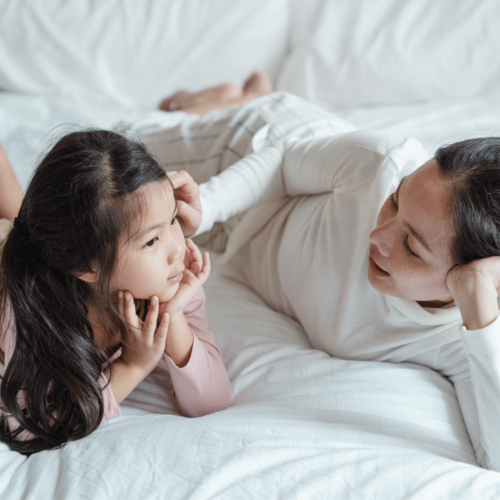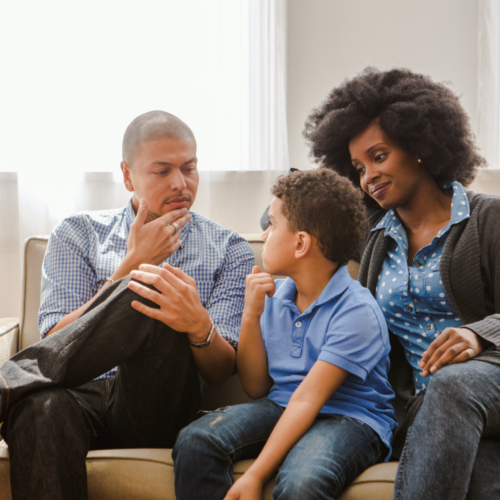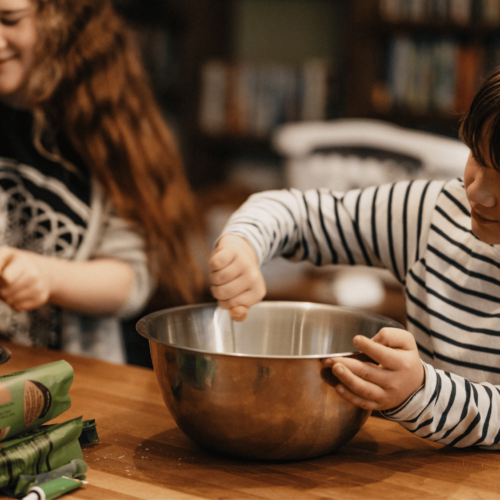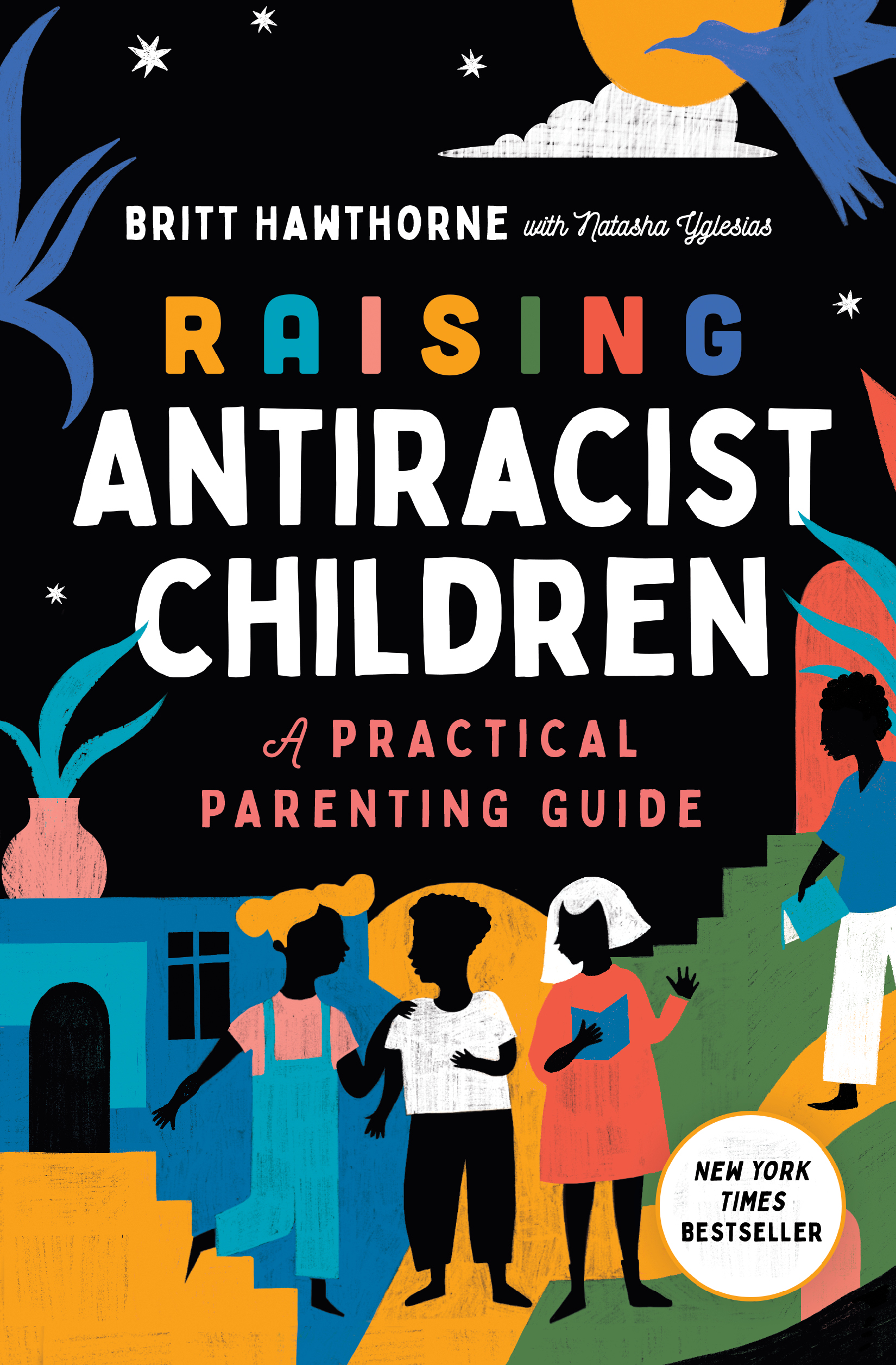Let’s think back to a time when your child said, “That’s racist!” Or, think ahead to a time when that may happen. What is an antiracist practice to guide these conversations? I’d like to share what it means to be a Black family that discusses racism and teaches our children how to dismantle it. Here’s a peek into our practice.
Reparenting reminder: racism is a system of advantage based on race, in the United States white people are advantaged, and People of the Global Majority are disadvantaged.
So, Your Kid Says That’s Racist—Now What?
First, let’s start with why grownups should have a thoughtful response. Critical conversations often happen at unexpected times or places. Critical conversations need to happen when someone has said or done something that’s rooted in racism or risks harming, excluding, or othering people. An antiracist practice requires us to engage in empathic and accurate conversations with our children.
That’s racist is a common statement young people make when practicing calling out discrimination and meanness. Identifying and acknowledging is an essential start so we can dismantle it. And, how we reply matters.
Here’s Why That’s Racist Is Not a Catchall
“Hey! It’s my turn to ride the bike.” yelled a white 11-year-old kid to his friend. When his friend declined he said, “stop being so racist.” If your child is calling out meanness, an individual act that was rude, or something else, then correctly identify the behavior as rude, mean, or unkind. This is especially true for white children who use the term racist to be an insult. It’s imperative to correct this behavior; otherwise, it’s clouding their understanding of the psychological toll and discrimination People of the Global Majority experience because of racism.
“The president is a racist!” Our children need to know that calling someone a racist isn’t a slur or an insult. It should never be used to hurt someone’s feelings or without analysis. The label racist is reserved for a system of advantage based on race or a person upholding the racist system. Simply identifying the system doesn’t dismantle it. It will take individual advocacy and collective action. We want our children to know that we live in a racist society, and sometimes it’s difficult to identify racism. They can always ask us to help them notice, understand, and challenge racism.
How To Respond When Kids Identify Racism At Unexpected Times and Places
When you’re building an antiracism practice with children as an educator or caregiver, it’s really helpful to have a standard practice for engaging in critical conversations. White supremacy and patriarchy teach systems of authoritarianism and “power-over” dynamics. In these systems, asking questions, admitting you’re wrong or that you don’t know something, and taking space are shamed. We’re striving to undo these harmful patterns.
To facilitate a culture of inclusivity and openness, here are three easy practices to help you when you feel overwhelmed or surprised as a teacher or parent.
1. Take a Deep Breath
Get back in your body and out of your head. Take a slow, deep breath. Ask the children you’re caring for to join you. You can make this a regular practice to employ tools to encourage deep breathing.
Mr. Chazz suggests a hand windmill with a fresh flower attached at the base to encourage deep inhales and exhales with younger kids or practice balloon breathing with Teacher Joel from Yoga Ed
2. Connect
Take a moment to quickly connect with your child. This might be a small smile or nod, holding their hand or rubbing their back. If your child is calling out racism, chances are their bodies are activated with big emotions. It’s important to connect with your child right away. This will also allow you to take a beat to assess your next move. If your initial response shut down the conversation or shamed your child for calling it out, it’s totally okay to say, “How I handled that wasn’t okay. Can we try again?”
“You and your child are partners in creating spaces and a world where addressing dehumanizing and racialized harm are the norm, not the exception.” – Katie Kitchens and Kerry Librando
3. Allow Space
Allow space and room to learn. Encourage questions and conversation. An antiracism practice is about curiosity and teaching children, and about reparenting yourself in the process.
How You Reply Matters
How we reply to important conversations matters. When we reply, let’s encourage these messages and set the foundation for antiracism practices in your classroom or home:
- Your observations are valid and worthy to be discussed
- It’s okay to identify and acknowledge racism
- We’re on the journey of learning together
- Racism won’t be a taboo conversation in our home
- Your questions are welcomed
- You won’t have to figure it out alone
Your Roadmap to Navigating That’s Racist With Kids
Now that you have a protocol for expansiveness and conversation, you can address whatever comes up specifically. In this case, let’s discuss how to address when kids say that’s racist.
1. Help the Child Understand and Identify the Label
Ask the child about the situation and context behind their comment. Consider saying:
- “Tell me more.”
- “I notice you’re practicing finding racism. What made you think it was racist?”
2. Is That’s Racist Being Used Accurately?
Was the situation or interaction racist? Or, did they witness something unkind or rude and mislabel it as racist? As antiracist caregivers and educators, we are modeling the correct use of the term racist and if our children ask what’s racist we use this definition:
Personal prejudice + systemic misuse and abuse of power.
3. a) If No, Then Correct The Behavior. What Is the Underlying Pattern To Address?
Help the child understand the difference between racism and unkind or rude acts and words. Discuss a few examples. And, open the door for more conversations about racism and how to identify it based on the definition above.
3. b) If Yes, Then Direct the Conversation Toward Education and Accountability
As an antiracist family, we’re actively practicing identifying racism in books, TV shows, movies, and everyday experiences using this definition. While watching Dreamwork’s “How to Train Your Dragon 2” Cobe (age 7) said “this movie is racist. Why is the only Black guy the bad guy?” From there Carter, Cobe, and I had a really fruitful conversation.
In these moments, consider asking:
- “That’s an important observation. Can you identify who is benefiting and what systems are supporting it?”
- “Yes, I agree. Can you tell me the prejudice + misuse of power?”
- “Who is being erased or misrepresented?”
- “What’s the power dynamic or system being used?”
3. c) If You’re Not Sure, Allow Space
It is okay to share with children that you don’t know. This cultivates so much openness and trust. Consider saying:
- “You’ve asked me a question that I don’t know the answer to. Can we research it together to find out more?”
4. For Families of the Global Majority
When your child experiences racism, it’s important to stress that
They aren’t being mistreated because of their skin color, they’re being mistreated because of racism. It’s a small, yet powerful distinction. This clarifies that there’s nothing wrong with their skin color and racism is to blame. In our home, we have found success saying: “That was racist. I don’t know where they picked that idea/phrase/action up. I hope they work to put it back down.”
5. For White Families
Because of white supremacy, white children are missing out on loving friendship, joyous experiences, and fully connecting to their humanity due to their developing racial prejudice. Making and maintaining cross-racial friendships through adolescence means white children will need to learn how to listen to stories of racism and how to support their friends of the global majority through racist incidents. Starting these conversations early and often helps white children to process and understand their role in creating a just world. For more support, check out the practice How Can Children Support Friends Who Just Experienced Racism? in Raising Antiracist Children.
Whiteness Is Not a Heritage to Celebrate
More and more in recent years – typically during Black History Month – I’ve come across the question, “Why isn’t there a white history month?” It is important for us to understand that whiteness is not a heritage to celebrate; it is a racial category. Even then, whiteness’s “constant characteristic is change. Whiteness has changed over time, over place. And, in the myriad situations of human ranking,” explains Nell Irvin Painter, author of “The History of White People.” Whiteness is a racial category whose bounds have shifted repeatedly over time. It is important for us to understand this history of whiteness, but that is not the same as finding a reason to celebrate it.
Daniel Hirschman, assistant professor of sociology at Brown University, reminds us that “calls to celebrate whiteness ignore the institutionalized celebration of whiteness that’s built into the very fabric of our day-to-day lives, along with the more overt celebrations in every history textbook.” In other words, whiteness is already celebrated everywhere: in our schools, in our government buildings, and in our cultural norms. Arguing that whiteness deserves to be celebrated one month each year ignores the widespread celebration of whiteness that already exists. This argument also misunderstands equality. “Equality only works if everyone starts at the same place, which in the cases of both gender and race is quite simply not true. It is why the idea of white history month is completely unnecessary and a Black History Month is,” says Richard Sloat.Whiteness is not a heritage to celebrate, yet our society so thoroughly celebrates whiteness that sometimes folks don’t even realize that’s what is happening.
Are You an Antiracist Parent or Educator? Join Me
As teachers and caregivers, we’re learning how to model antiracism to future generations, while reparenting ourselves. Explore tools and tips for building an antiracism practice with your classroom and family. I’m rooting for you.





